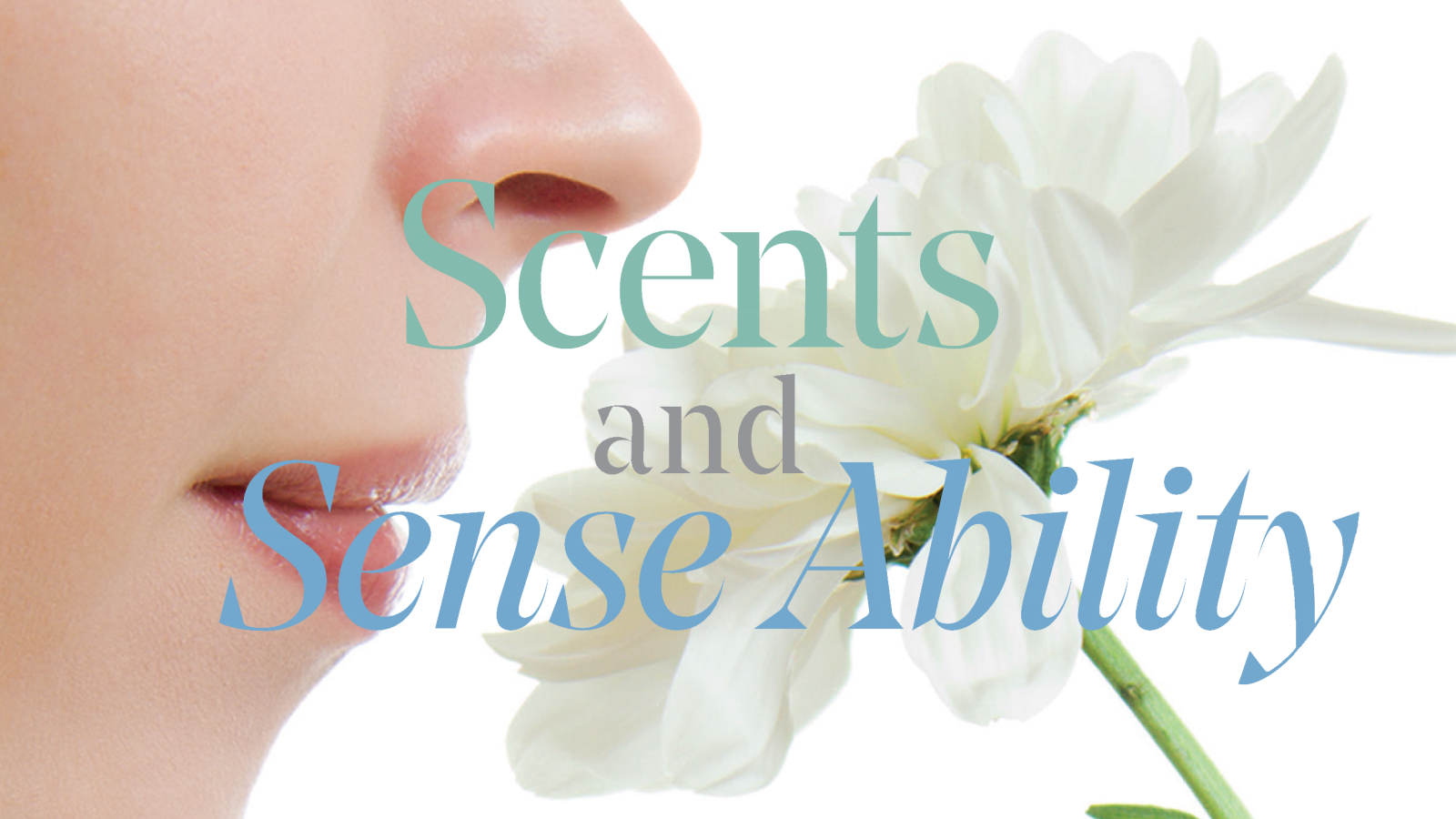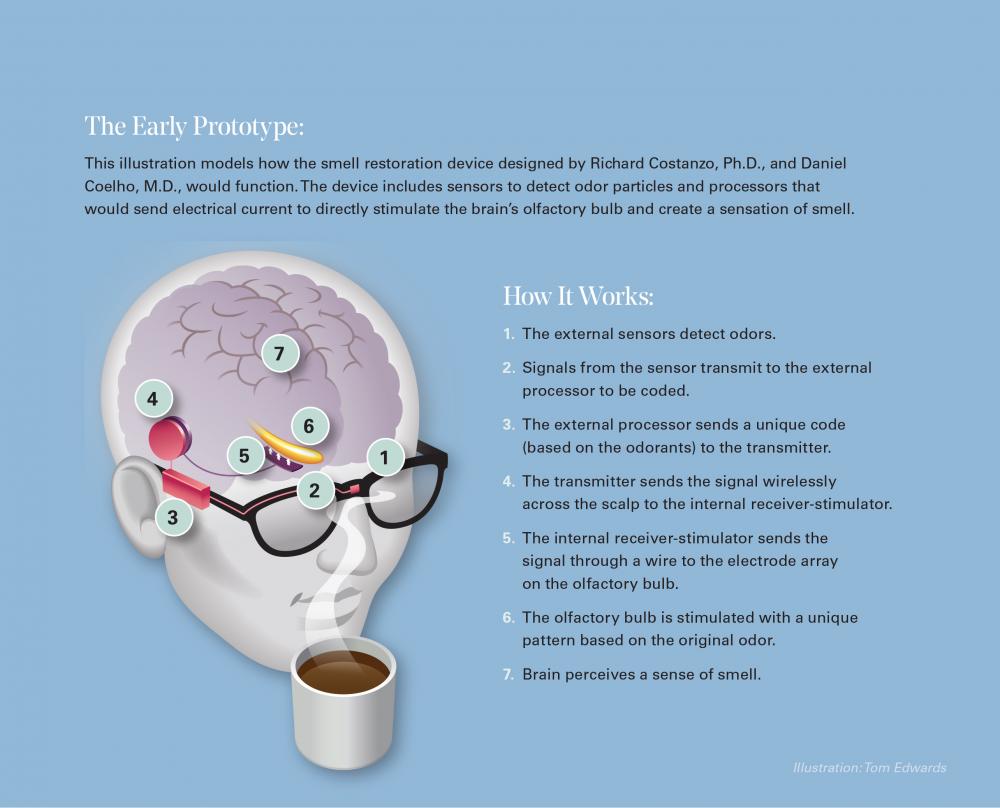
Scents and Sense Ability
Lately, researchers noted that losing the sense of smell, or anosmia, is a common symptom of COVID-19 patients. Two VCU researchers are studying the occurrence of anosmia in COVID-19 patients. For them it’s a natural growth of their work to create a way to restore a sense of smell to individuals who have lost the ability when the nose’s neural pathways are severed from the olfactory bulb.
Their smell restoration research is a collaborative, grassroots initiative originating here at VCU Health that applies existing technology to a new problem to restore smell through electrical stimulation.
We first wrote about this smell restoration research in NEXT magazine. Excerpts of that article are shared below, and the full text can be found at www.mcvfoundation.org/next.
***
Imagine, for a moment, never enjoying your favorite smells again — gone are the aromas of fresh-baked cookies, clean sheets or a favorite scented candle. Gone too is the ability to enjoy the flavor of favorite foods and drinks. And the ability to recall cherished memories so closely linked to smell vanishes without a trace.
This condition — the complete loss of a person’s sense of smell — is called anosmia. Researchers have found it challenging to know how many people are affected by it. Grant funding for more thorough assessment and study of the condition has been scarce, but the most current studies estimate around 3.4 million people, or 3.2% of the general U.S. adult population, suffer from complete or severe loss of smell.
The problem’s scope receives less attention than vision and hearing disorders, but anosmia has an unseen cost. Losing olfactory system function can dramatically affect a person’s quality of life. People report an inability to enjoy food and flavors. Anosmia patients also face significant lifelong safety risks when they can no longer detect threats, such as gas leaks or spoiled food.
No treatment currently exists, and that’s been a nagging problem for Richard M. Costanzo, Ph.D., professor emeritus and director of the Smell and Taste Disorders Center in the VCU Health Department of Otolaryngology — Head and Neck Surgery. The clinic is one of the few of its kind in the country, and rarely a week goes by that Dr. Costanzo doesn’t hear from another person seeking help. Dr. Costanzo’s lab investigates methods to promote regeneration and repair of the olfactory system.
EXISTING TECHNOLOGY MEETS AN UNSOLVED PROBLEM
Since Dr. Costanzo arrived at VCU in 1979, he’s been trying to develop a clinical solution for patients experiencing the complete, neuronal-based loss of smell. The condition is common in people who have experienced head trauma, when temporary displacement of the brain can sever connections between neurons in the nose and the olfactory bulb. Recent advances in understanding how the olfactory system functions and can be mapped provided him with the inspiration to continue searching for a solution.
Dr. Costanzo said he was envious of what could be done for hearing loss by colleagues like Daniel M. Coelho, M.D., Douglas Hayden Professor of Otology, Neurotology and Skull Base Surgery and director of the Cochlear Implant Center at VCU Health. Dr. Coelho has expertise in cochlear implants, the complex devices that bypass damage to the normal hearing process in order to directly stimulate the auditory nerve with electrical signals that provide a sense of hearing to individuals with severe hearing loss.
“I’ve been searching my whole career for a way to help people with loss of smell, and not so far away in the human head is another sense with a wild success story,” Dr. Costanzo said. “I thought, it’s too bad we can’t do that. Dan and I were talking one day, and he told me, ‘You know with hearing we use a strategy where we can bypass the damage and stimulate the nervous system and restore hearing, so why can’t we do that for a sense of smell?’”
Their conversation led to a research partnership both describe as fortuitous, given their respective expertise. They received critical funding from the MEDARVA Foundation for their early stage research. The grant helped keep the research project alive, enabling Drs. Coelho and Costanzo to establish proof of concept on a high-risk venture, and inspired additional private support.

ESTABLISHING PROOF OF CONCEPT
The team conducted two studies to test their theories about creating smell perceptions using electrical stimulation of the olfactory bulb. Their first experiment confirmed that different odors produced different neural activity within the olfactory bulb. A second study confirmed that direct stimulation of the olfactory bulb created spatial patterns of neural activity similar to those observed during normal, functioning olfaction. Both studies supported the theory behind using electrical stimulation for treatment of anosmia.
While the idea of restoring a sense of smell through electrical stimulation poses technical hurdles, the studies suggest that unique perceptions can be achieved by using the same principles of highly focused patterns of electrical stimulation to the olfactory bulb.
MAKING FUTURE SENSE
Drs. Coelho and Costanzo are continuing their research on smell restoration and developed prototypes using the same technology behind cochlear implants, with both external sensors and internal processors. They are cautiously optimistic about the direction of their project and are working to refine sensors on prototypes and thinking through the design of surgical protocols that will ensure patient safety and effectiveness with the device.
Both are realistic about what to expect as their research continues. The olfactory system is more sensitive and more complicated than hearing and even vision. The human nose can distinguish around 1 trillion different odors according to research in the journal Science. However, the ability to fine-tune a device to that level of discrimination may not be necessary. For example, the scent of a rose can include up to 275 unique odorants, but only a small fraction of them may be required for a person to identify what they’re smelling. The initial aim for Drs. Coehlo and Costanzo is not to achieve perfect detection of certain scents, but they are not shy to say they hope that ultimately may be possible.
“Our first goal is to achieve some sort of smell perception,” Dr. Coelho said. “We’re currently planning human pilot studies that will further our proof of concept.”
If you would like to learn more about Dr. Coelho’s and Dr. Costanzo’s research to develop smell restoration technology, read the full version of this article in NEXT magazine.


